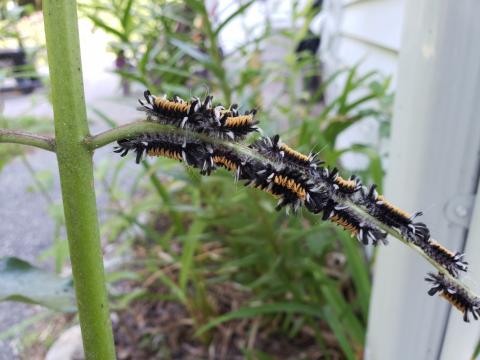What are the hairy caterpillars eating my milkweed? Are they good bugs?

Milkweed is most often thought of as the home and food source of monarch butterfly larvae. However, milkweed also hosts a wide variety of other insect species such as red milkweed beetles, milkweed aphids and a moth called the milkweed tussock (also known as the milkweed tiger moth). Just like monarchs, these species have evolved to be able to eat and accumulate milkweed toxins in their bodies as a defense mechanism. They also require milkweed as a food source in order to be able to complete their lifecycles.
Of the milkweed-feeding insects, milkweed tussock caterpillars can seem alarming because of their voracious appetites. Gardeners who grow milkweed specifically for monarch butterflies are often dismayed to find milkweed tussock caterpillars rapidly devouring their plants. This leads some people to question whether they are “good” bugs or if they should be killed to give monarchs a competitive advantage. Yet, milkweed tussock is a native species that evolved alongside the monarch. Knowing that species diversity is an essential part of a healthy ecosystem, there is no harm in leaving milkweed tussock caterpillars alone to eat a few milkweed plants.
Adult milkweed tussock moths emerge in early summer to mate and lay eggs. Adults are rather non-descript, with gray wings and hairy yellow-orange abdomens. Females may go unnoticed as they lay clusters of eggs directly next to one another on the undersides of milkweed leaves. The resulting caterpillars feed gregariously in clusters of ten or more throughout their first three instars (stages of development). The larvae are initially difficult to detect. They are pale yellow and bristly with black heads, and they prefer to eat on the undersides of leaves. As the caterpillars mature, they become covered in thick hairs with many black, orange and white tufts.
A group of milkweed tussock caterpillars can rather quickly consume entire milkweed plants except for the stem. The caterpillars usually eat all but the major leaf veins which are full of latex sap. This rapid feeding is especially noticeable in small gardens but would be otherwise overlooked in large meadows or fields. At the end of their development, the caterpillars pupate and spend the winter in a hairy cocoon. If you have milkweed tussock caterpillars in your own garden, let them be and enjoy observing them as they grow. You’ll likely find that they are just as fascinating as many other caterpillar species.
Got questions? The Ask UNH Extension Infoline offers practical help finding answers for your home, yard, and garden questions. Call toll free at 1-877-398-4769, Monday to Friday, 9 a.m. to 2 p.m., or e-mail us at answers@unh.edu.
Related Resource(s)
Do you love learning about stuff like this?
SUBSCRIBE TO Granite State Gardening newsletter
Got questions? The UNH Extension Yard and Garden Infoline offers practical help finding answers for your yard and garden questions.
Call toll free at 1-877-398-4769, Monday to Friday, 9 a.m. to 2 p.m., or fill out webform.
